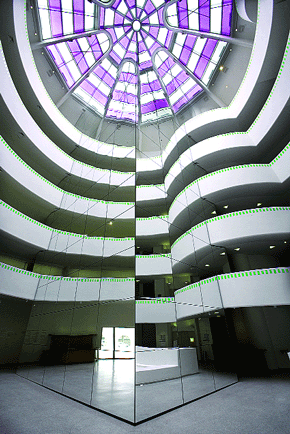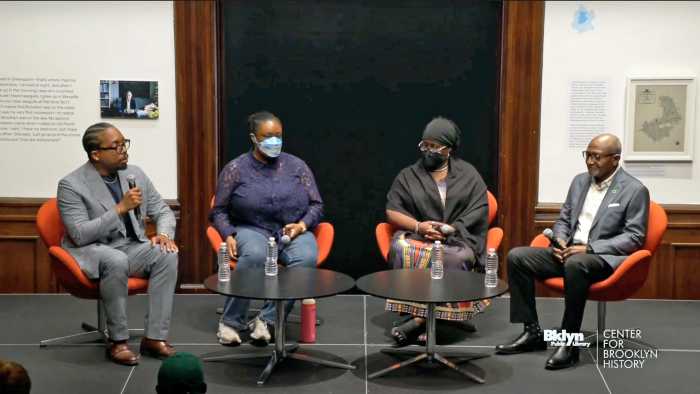The Guggenheim accommodates the effrontery of an insistent guest
In his 20s, the artist Daniel Buren, born in France in 1938, was inspired to paint on the striped canvases sold at Parisian textile markets at the time for ubiquitous use as café awnings. The various stripes of color on plain linen cloth were always the same two-inch width. Buren envisioned the canvas as a kind of painter’s version of the found object. He decided to orient the stripes vertically but the sizes and proportions of stretchers were permitted to change. What little paint Buren applied was always white, in plain bars at the edges, and an occasional scalloped pattern at top and bottom or side-to-side.
This highly schematic approach was Buren’s response to the late 1950s’ ethos of modernist painting.
In time, Buren began to think of the stripes as a portable concept, his “visual tool.” Instead of creating art works in the studio, he ventured out into the city and worked on the street. Over the next 35 years, Buren continued to develop simple, yet conceptually incendiary projects for innumerable public spaces, galleries and museums around the world, emblematic of his view that the autonomous art object was a fiction. According to Buren, works of art were either nested in museums or galleries due to commercial and other limiting decisions or, if outdoors, situated on public space amidst the forces of police power.
The notion of the nomadic studio as a form of political expression was in tune with the 1960s, and presaged the art movements to come. Other artists of Buren’s generation explored similar issues, but the economy, versatility, and longevity of his “visual tool” has been remarkable. Inventive, sly and visually arresting, Buren’s projects have infuriated some—among them fellow artists who censored his project for The Guggenheim International Exhibition in 1971. Great care was taken in compiling photographic documentation of Buren’s post-studio practice and its collective title is “Photo-Souvenirs.”
The opportunity as a mature artist to launch a Guggenheim project, in a vastly changed art world and political climate, presented a special challenge. Buren has come up with something big, appropriately named “The Eye of the Storm.” The project consists of three installations displayed in different areas of the museum, individually entitled “Around the Corner,” in the rotunda; “Wall of Paintings,” in the High Gallery; and “Color, Rhythm, Transparency, work in situ” in the Thannhauser Galleries. Video displays of the “Photo-Souvenirs are shown continuously in discrete nooks of the rotunda.
Visitors, ready to see something momentous, may think they have come to the museum on the wrong day when they first arrive inside the dimly lit entrance, with scaffolding soaring to a tarp hanging above.
However, after moving around the obstacle, the rotunda feels unusually open and bright. Several magenta gels on the circular skylight refract the light of like a stained glass window. Pink sunlight filters down upon the museum’s spiralling white parapet, embellished with stripes of shiny yellow-green paint.
The bays where art works are usually displayed are completely empty.
The scaffolding forms the support for a gigantic, mirrored sculpture whose panels jut at a right angle into the museum’s spacious atrium. The structure challenges the museum’s very being, as if part of an angled skyscraper has suddenly materialized in the Guggenheim’s ovoid environment, amplifying the light with its angled surface area, in keeping with the project’s installation during the summer solstice.
While dominating the rotunda’s open space, the sculpture also seems to disappear within the surrounding structure. As a visitor ascends the ramp, now on the bright side, now on the scaffolded side, the sculpture seems to shift. Chain link fencing in strategic places foils further exploration of the mirrored facade within touching distance at various levels.
Buren made a well-calculated bet that spectators traipsing up and down the ramps would want to keep sight of the central space. Their view of the reflections and perspectives of this space—which includes their fellow visitors—changes step by step, level by level. People who stop to gaze into the rotunda’s void seem to be in two places at once—in view on the ramp as well as reflected in the mirrored walls. Because of the sculpture’s hard right angle, the chimera of seeing people moving in reverse introduces another perspective.
A spectator on the ground floor sees a line of heads continually bobbing above the green stripes, growing smaller as they rise. What better way to bring the museum to life than by choreographing its visitors?
The ground floor of the Guggenheim is the ideal point for watching the serene center of this storm of spectators as they walk around the ramps. This aspect of the installation will amuse some visitors or not even register with others.
At the ramp’s second level, the alcove called the High Gallery features “Wall of Paintings,” a seminal group of canvases that Buren painted between 1966 and 1977. These are some of the schematic paintings made of striped awning material and white paint. Reassembled from a private collection and hung salon-style on the enormous walls of the High Gallery, they make a powerful visual statement. Reflected and gently distorted in the mirrored panels, their optical reverberations multiply and probably add subtle color effects to the rotunda.
The final section of “The Eye of the Storm” is on the walls and windows of the cylindrical annex spaces adjacent to the Thannhauser Galleries. Window gels in bold colors and patterns are reflected in mirrored bars—at the signature width, of course—affixed to convex walls opposite them. Again there is a sense of play with the spectator’s changing position and the museum’s circle-themed architecture. The intention here was to play off a selection of paintings in the Guggenheim’s collection featuring works by Klee, Kandinsky and other early modernist painters who split space and color into ambiguous perspectives within the picture plane. Although the distance between them and the bold graphics of the window treatments is too great to reconcile visually, the juxtaposition is revealing.
Buren’s oeuvre is ultimately rooted in both modernism and early 20th-century avant garde experiments in art, graphic design, photography, architecture and politics.
gaycitynews.com

































